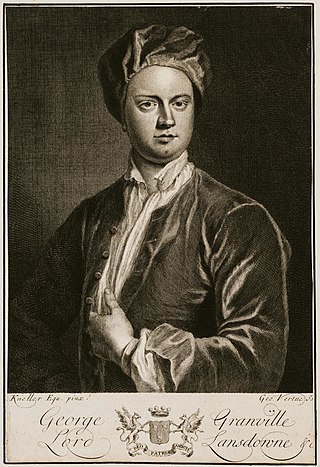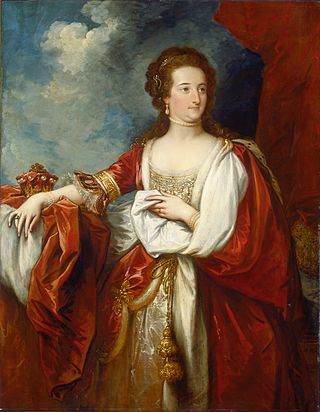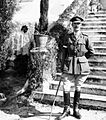
John Howard, 1st Duke of Norfolk, also known as Jack of Norfolk,, was an English nobleman, soldier, politician, and the first Howard Duke of Norfolk. He was a close friend and loyal supporter of King Richard III, with whom he was slain at the Battle of Bosworth in 1485.

Thomas Howard, 2nd Duke of Norfolk, styled Earl of Surrey from 1483 to 1485 and again from 1489 to 1514, was an English nobleman, soldier and statesman who served four monarchs. He was the eldest son of John Howard, 1st Duke of Norfolk, by his first wife, Catharina de Moleyns. The Duke was the grandfather of both Queen Anne Boleyn and Queen Catherine Howard and the great-grandfather of Queen Elizabeth I. In 1513, he led the English to victory over the Scots at the decisive Battle of Flodden, for which he was richly rewarded by King Henry VIII, then away in France.

Field Marshal Sir George Howard KB, PC was a British military officer and politician. After commanding the 3rd Regiment of Foot at the Battle of Fontenoy in May 1745 during the War of the Austrian Succession and after commanding that regiment again at the Battle of Falkirk Muir and the Battle of Culloden during the Jacobite Rebellion, he returned to the continent and fought at the Battle of Lauffeld. He went on to command a brigade at the Battle of Warburg during the Seven Years' War. He subsequently became the Governor of Minorca.

Stoke Poges is a village and civil parish in south-east Buckinghamshire, England. It is centred 2.7 miles (4.3 km) north-north-east of Slough, its post town, and 2 miles (3.2 km) southeast of Farnham Common.
Elizabeth, Lady Coke, was an English court office holder. She served as lady-in-waiting to the queen consort of England, Anne of Denmark. She was the daughter of Thomas Cecil, 1st Earl of Exeter, and Dorothy Neville, and the granddaughter of William Cecil, 1st Baron Burghley. She was the wife of Sir William Hatton and later of Sir Edward Coke.

Major General Richard William Howard Howard Vyse was a British soldier and Egyptologist. He was also Member of Parliament (MP) for Beverley and Honiton.

George Granville, 1st Baron Lansdowne PC, of Stowe, Cornwall, was an English Tory politician who sat in the English and British House of Commons from 1702 until 1712, when he was raised to the peerage as Baron Lansdown and sat in the House of Lords. He was Secretary at War during the Harley administration from 1710 to 1712. He was also a noted poet and made a name for himself with verses composed on the visit of Mary of Modena, then Duchess of York, while he was at Cambridge in 1677. He was also a playwright, following in the style of John Dryden.
Lieutenant-General Thomas Howard, 2nd Earl of Effingham, styled Lord Howard from 1731 to 1743, was a British nobleman and Army officer, the son of Francis Howard, 1st Earl of Effingham.

William Beckford of Somerley was a Jamaican-born planter and writer who wrote on the topography and conditions of slavery in the British colony of Jamaica and the history of France.

The Smalbroke family was a powerful landed gentry family between the early 15th and early 19th centuries, owning large areas of land in Birmingham, England.

General Richard Vyse or Vise FRSE was a British general, and briefly a Member of Parliament for Beverley.
George Pitt-Rivers, 4th Baron Rivers, known as George Beckford until 1828, was a British peer and politician. He held a place as a Lord-in-waiting in several governments, migrating from the Tory to the Liberal Party over the course of his career. He commanded the Dorsetshire Yeomanry Cavalry for a decade. His four sons all suffered from a lung disease, and only the youngest briefly survived him to inherit the barony.
Lieutenant-General Thomas Howard was an officer of the British Army and the ancestor of the family of the present Earls of Effingham.
Major General Sir Richard Granville Hylton Howard-Vyse was a cavalry officer in the British Army.

Sir William Moleyns was an English landowner, administrator and politician from Stoke Poges in Buckinghamshire.
William Granville, was the Treasurer of Ceylon, Commissioner of Stamps, and a member of the Executive and Legislative Councils.

Elizabeth Howard, Countess of Effingham, formerly Elizabeth Beckford, was the wife of Thomas Howard, 2nd Earl of Effingham, and the mother of both Thomas Howard, 3rd Earl of Effingham, and Richard Howard, 4th Earl of Effingham.

The Ven. William Vyse, FRS, FSA was Archdeacon of Coventry from 1793 until his death, and Chancellor of Lichfield from 1798.
Edmund Halsey, of St. Saviour's, Southwark, Surrey and Stoke Poges, Buckinghamshire, was a British brewer and Whig politician who sat in the House of Commons between 1712 and 1729. He enjoyed a rags-to-riches career, from working as a ‘miller’s boy’ at St. Albans to becoming the owner of one of the largest breweries in the London area.

West Retford Hotel in Nottinghamshire is a building of historical significance and is Grade II listed on the English Heritage Register. It was built in the 18th century, possibly around 1740, and was the home of many notable people over the next two centuries. Today it is a hotel which provides accommodation, restaurant and bar facilities and caters for special events.


















